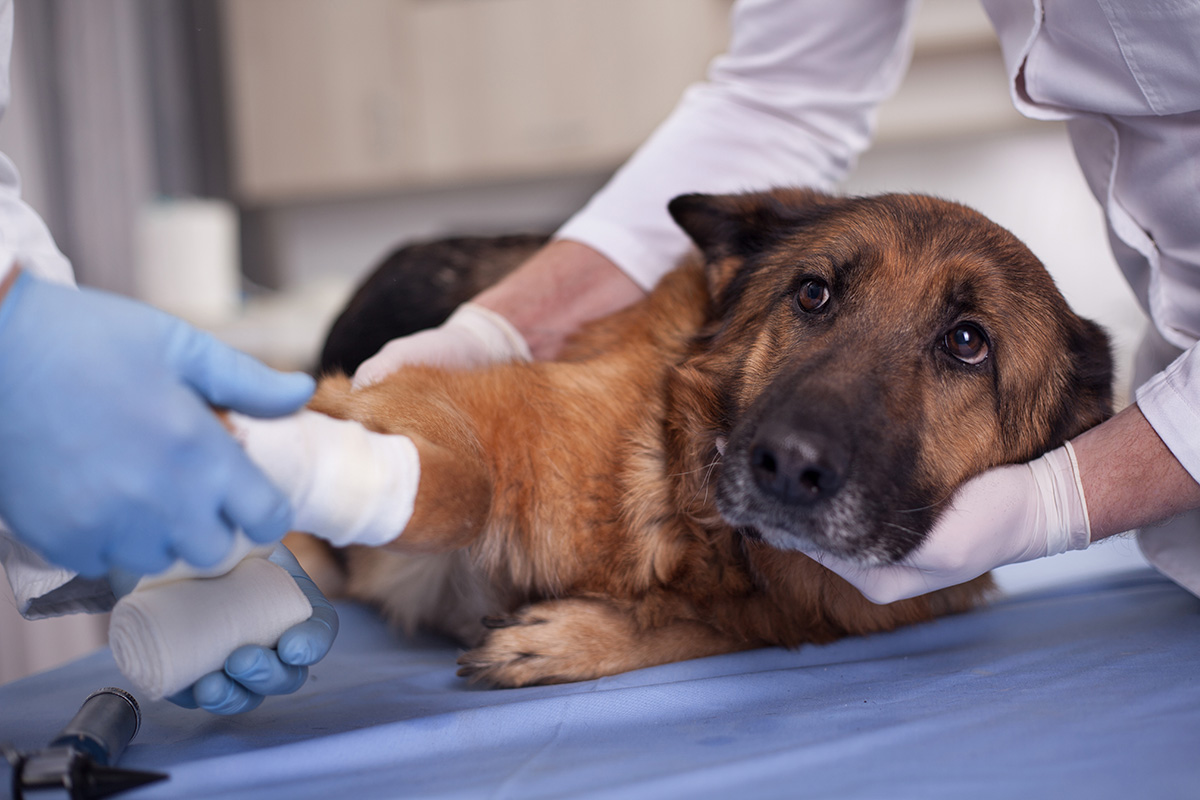
Being equipped with basic pet first aid knowledge can make a significant difference in ensuring the well-being of your dog and may even help save their life, in the unfortunate case of a health event or injury.
Know your dog’s vital signs
This is a good place to begin because you need to know what’s considered ‘normal’ if you’re to diagnose something as ‘abnormal.’
- Normal temperature: 38° – 39°C
- Normal heart rate: 70-160 beats/min
- Normal breathing rate: 10–30 breaths/min
To check vital signs:
- Don’t assume your dog won’t bite (especially if they’re in pain).
- Use rectal, not oral, thermometers. Newer human digital thermometers are best.
- Check your dog’s heart rate by placing your hand over their chest, just behind their elbow.
- Measure your dog’s breathing rate by observing your dog’s sides or by holding your wet finger in front of the nose.
- Measure both rates for 15 seconds and multiply by 4 to get the rate per minute.
Here are some common situations/conditions that require first aid, and how to perform the procedures:
Bleeding
- Possible causes: Car accident, animal fight, fall, clotting problem, rat poisoning, severe wound.
- What to do: Bleeding from an artery is an immediately life-threatening situation. Arterial blood is bright red, bleeds in spurts, is difficult to stop, and requires immediate veterinary attention.
- For any type of external bleeding, place a clean cloth or sterile gauze over the injured area.
- Apply direct pressure for at least 5–7 minutes to stop bleeding.
- Do not apply a tourniquet unless absolutely necessary.
- Keep your dog warm by wrapping them in a blanket and take them to a vet immediately.
Vomiting
- Possible causes: Poisoning, abdominal injury, motion sickness, disease, overeating, fear, brain injury, parasites.
- What to do: Examine vomit for blood or other clues as to the cause. Also, bring a sample of the vomit to your veterinarian when you take your dog for an evaluation. If your pet may have eaten something poisonous, bring a sample of the suspected poison (preferably in its original packaging) to the veterinarian.
- Do not offer any food or water until a veterinarian has been contacted.
- Abdominal pain, enlarged stomach, and dry heaves are serious signs. Call your veterinarian immediately.
Heatstroke
- Excessive heat and/or lack of shade, heavy exertion, lack of water (Note: Animals differ in how much heat they can tolerate; even mildly warm, humid temperatures can stress some pets).
- What to do: Place your dog in a cool or shaded area and immediately begin to cool them down – but do this slowly. Don’t apply ice packs to the dog. The technique you choose will depend on the size of the dog and availability of items, here are some options:
- Bathe or gently hose with cool water. Do not leave your pet unattended while soaking them in the bath.
- Soak a towel in cool water, drizzle the water over your dog, focusing on the head, stomach, under the neck, inner thighs and pads of the feet.
- Wrap the dog in a cool, wet towel.
- Monitor their rectal temperature. You can dry them when their temperature drops to 39°. Do not allow your dog to become excessively chilled (wrap them in a dry towel or blanket). Continue checking their temperature and take them to the vet for further treatment. Take them to a vet immediately if their temperature is 40°C or above.
Limping
- Possible causes: Broken limb or toe, arthritis, injury to footpad, dislocation, sprain, muscle soreness or a burr between their toes.
- What to do: If a fracture is suspected, gently stabilise the limb before you transport the dog to the vet. (See ‘Handling and transporting tips’ below.) Cover any wounds with a clean cloth.
Bee or wasp sting
For bee stings, apply a paste of baking soda and water. For wasp stings, apply vinegar or lemon juice. Also, apply a cold pack and follow up with calamine or antihistamine cream. In case of severe swelling or difficulty breathing, immediately take your dog to the vet.
Choking
- Possible causes: Foreign object—such as a bone, food, or part of a plant—lodged in the throat, windpipe or teeth; choking could also be caused by an allergic reaction.
- What to do: This is an emergency, so transport your pet to a vet immediately. On the way you could:
- Gently pull the dog’s tongue forward and inspect their mouth and throat—but be careful! You must make sure your dog doesn’t try to bite you. Stop if they are not cooperative.
- If you see a foreign object, hold the mouth open and attempt to remove it by hand, or with tweezers or small pliers.
- Take care not to push the object farther down the throat. Again, stop if the dog is not cooperative and immediately take them to a vet. If the dog is not breathing, see ‘CPR’ below.
Unconsciousness
- Possible causes: Drowning, electrocution, trauma, drug ingestion.
- What to do: Take the dog to a vet as soon as possible.
- In case of drowning, remove fluid from the dog’s lungs by lifting his hindquarters high over his head and squeezing his chest firmly until fluid stops coming out.
- In case of electrical shock, DO NOT touch pet until they are no longer in contact with the electricity source.
- If an object is blocking the dog’s windpipe, it will need to be gently removed. See ‘Choking’ above. Take the dog to a vet as soon as possible.
- If the dog is not breathing and has no heartbeat, start CPR.
CPR
NOTE: It is advisable to seek assistance in transporting both yourself and your dog to the nearest veterinarian, while you carry out the CPR procedure as outlined below. In the event of any obstruction in the windpipe, you should take the following steps: gently open your dog’s mouth, carefully pull the tongue forward, extend the neck, and sweep your finger inside the mouth to clear any blockages. However, caution is necessary to ensure that your dog does not attempt to bite you.
- Check for breathing and a heartbeat: Check to see if the dog is breathing and check for the presence of a heartbeat. If you don’t see your dog’s chest moving and can’t find a heartbeat, begin CPR with chest compressions.
- Give chest compressions:
Place your hands on your dog as follows:
For small dogs and deep chested dogs, place the heel of one of your hands directly over the pet’s heart and place your other hand directly over the first hand.
For deep chested dogs, place the heel of one hand over the widest part of the chest and place your other hand directly over the first hand.
For barrel chested dogs, place the dog on their back, place one hand over the widest part of the sternum, and place your other hand directly over the first hand. Lock your elbows and make sure your shoulders are directly above your hands.
Then, push hard and push fast at a rate of 2 compressions per second, compressing 1/3 to 1/2 the width of your pet’s chest. Make sure the chest fully recoils before compressing again.
Perform 30 chest compressions.
- Then give artificial breaths:
Gently close the dog’s mouth and extend their neck to open the airway.
Cover your pet’s nose with your mouth and exhale until you see their chest rise.
Give a second artificial breath.
- Continue CPR: Continue giving CPR with a cycle of 30 chest compressions and 2 artificial breaths until your dog begins breathing again on their own.
- Check again for breathing and a heartbeat: Briefly check for breathing and a heartbeat every 2 minutes.
Monitor the dog for signs of life (consciousness, response, movement, breathing) regularly.
- Get to a vet: Continue CPR until you reach a veterinary hospital.
Handling and transporting tips
When dealing with an injured dog, it is important to avoid hugging them or getting too close to their head. In case of necessity, you can use gauze, soft towel strips, or stockings to muzzle the dog. Keep in mind that even a normally calm dog may bite when in pain. It is not recommended to lift or drag a large injured dog. Instead, you can create an improvised stretcher using a board, throw rug, blanket, or even a child’s toboggan. Before moving the dog, try to stabilize any injuries. You can use rolled magazines or newspapers as splints. Make sure to pad the limb generously with rolled cotton and gauze, or use pillows, strips of blanket, or towels as substitutes.
Helpful items to have on hand
- Gauze pads, gauze rolls, rolled cotton, and veterinary self-adhesive elastic wrap
- Calamine lotion and petroleum jelly
- Thermometer
- Blunt-end scissors (to cut bandages or cut fur away from a wound)
- Tweezers and pliers
- Antibiotic cream and antiseptic solution
- Extra blankets, towels, and pillows
- Eyedropper
- Tube socks (for slipping over an injured paw)
- Transport aids, like crates and carryalls. A child’s plastic toboggan or flat piece of board can be used to carry a larger dog.
- Cotton swab sticks
Here are a few key points to keep in mind: First aid for a dog is primarily the initial assistance you provide before seeking more comprehensive treatment from a veterinarian. Additionally, we advise you to consider printing this valuable information and keeping it easily accessible, just in case, although we hope you will never have to use it.

